
Our farmhouse looked a lot like other northern New England farmhouses when we first moved in: short on landscaping but long on charm. Green grass grew right up to the old stone foundation.
There was one nice flowering shrub, however – a 20-foot-tall beauty, shaped like a lollipop, with no mower damage to the thick, rough-barked trunk. The tree was covered in yellowish blossoms in the spring that led to plump, black-and-blue berries in the fall. One day that first winter, I watched a crew of cedar waxwings gorge themselves on the last of the berries.
So I was surprised when a friend of mine, visiting the farm for the first time, said, “Too bad about the buckthorn.”
The buckthorn? Our prized shrub? “Yes – that’s a buckthorn all right, one of the worst of our invasive, exotic species.”
I mentioned to my wife that we had an invasive exotic in the front yard. “Doesn’t look too invasive to me,” she replied, and I had to concede the point. Our lovely shrub was surrounded by grass, with no little buckthorns anywhere to be seen.
The following fall, I was in the woods with our forester. She pointed out a growing army of spiky seedlings that were sprouting in every opening and along the edges of the field. “Buckthorn,” she said, and when I recounted the sweet tale of the cedar waxwings from the previous winter, she said, “Well, that explains all these.”
In case you haven’t yet made the acquaintance of buckthorn, it’s not hard to do. There are only two shrubs with thorns in our part of the world. There’s the native hawthorn, with elephant-gray bark and 2-inch-long, widely spaced thorns. Everything else is a buckthorn. There’s the European variety and the glossy variety, and they look more similar than not, with vaguely round leaves, short thorns on the end of stubby twigs, and dark, rough bark. The best time to spot buckthorn is in late fall, when it is the last shrub in the forest to lose its leaves.
Buckthorn is an enemy combatant in the “invasive wars” that, you may have noticed, are raging in conservation circles across Vermont and New Hampshire. Other public enemies include Japanese knotweed, Eurasian milfoil, purple loosestrife, Russian olive, honeysuckle, and at least a half dozen more.
Conservationists point out, correctly, that these introduced species are running rough over the countryside, choking out many of our native plants and, in the process, degrading the habitat of many native birds and animals. Though many of our favorite local plants have flatlander roots – lilacs and earthworms come immediately to mind – advocates of the war on invasive plants point out that the speed and magnitude of the problem has increased dramatically as global trade and travel have connected our corner of the world to every other corner of the world.
But there’s a case to be made that, despite all this, the war on these plants ought not be waged. The 10,000 years since the ice retreated from Vermont and New Hampshire is just an ecological blink of an eye. Every one of our local species was an invasive at one point, right down to the sugar maple and white pine. Ecosystems are inherently dynamic, not static, so why should we dig our heels in as if the current ecosystem were, instead of a moving picture, some sort of engraving? Especially when our “native” ecosystem has been heavily disrupted by European colonization and agriculture since the eighteenth century?
The second objection is more practical. With many daunting issues facing our local environment, is pulling weeds the best use of our collective time, especially when some of those weeds have already naturalized and are sure to grow back? Japanese knotweed and Eurasian milfoil are two invasives that most experts agree will never be eradicated from New Hampshire and Vermont no matter how hard we try. The horse is already gone, so to speak; at what point does closing the barn door cease to be a priority?
Back on our farm, I remain ambivalent. I grabbed the chainsaw and dispensed with the prized shrub in the front yard, the grandmother of all the young buckthorns in our woodlot. And I now wage a campaign in our woods each November, armed with chainsaw and pruning shears, when the still-green buckthorn leaves stand out against the reddish-brown twigs and detritus of autumn.
But I’m under no illusion that I’ll ultimately be able to eradicate buckthorn from our limited holdings. I do it because inaction feels like acquiescence, and I don’t want to be a collaborator with the enemy. That said, I’m also unwilling to be a full-time foot soldier in a war that, when it comes to buckthorn at least, is already lost.


Discussion *